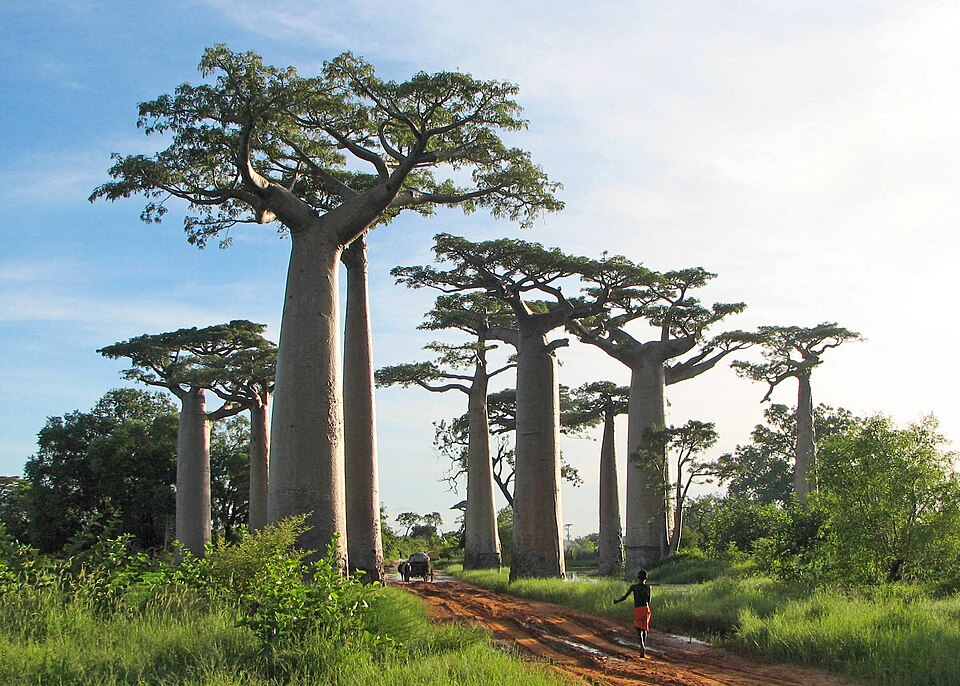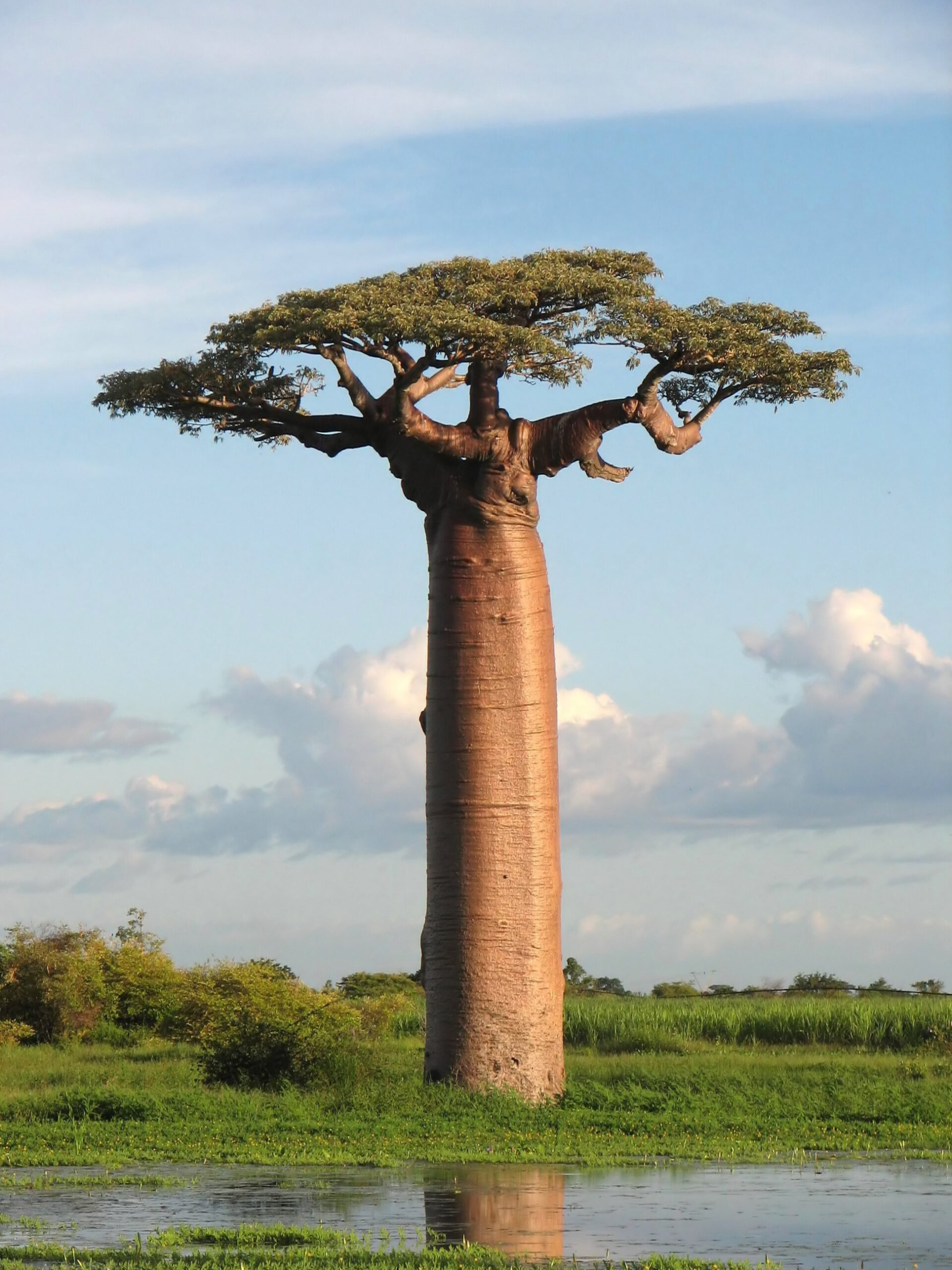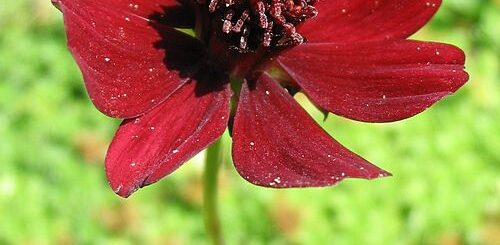Adansonia grandidieri – The Baobab Tree of Madagascar

The baobab is an iconic tree that has captured the imagination of travelers, botanists, and storytellers alike. Among the many species of baobabs scattered across the globe, one stands out for its size, beauty, and significance: Adansonia grandidieri, also known as Grandidier’s baobab. Native to the island of Madagascar, this tree has a storied history and plays a crucial role in the island’s ecosystem. But beyond its scientific importance, the Grandidier’s baobab is a symbol of resilience, adaptability, and the unique biodiversity of Madagascar.
A Look at Adansonia grandidieri
Adansonia grandidieri is one of the six species of baobab found on the island of Madagascar, and it is considered one of the largest and most striking. This species is known for its massive, swollen trunk, which can store large quantities of water, allowing the tree to survive in harsh, dry conditions. In fact, its trunk is often described as “bottle-shaped,” giving it a distinct, bulbous appearance.
The Grandidier’s baobab can reach up to 30 meters (about 98 feet) in height, with a trunk diameter of several meters. The tree’s large, pale flowers bloom at night and emit a strong, sweet fragrance. These flowers are typically white and about 15–20 cm in diameter. While the tree’s flowers are pollinated by nocturnal animals, such as bats, its seeds are dispersed by lemurs and other wildlife, playing a crucial role in maintaining the biodiversity of the regions it inhabits.

Adansonia grandidieri © Creative Commons | Author: Bernard Gagnon
Habitat and Distribution
Adansonia grandidieri is endemic to Madagascar, meaning it is found nowhere else on Earth. It primarily grows in the dry deciduous forests of western and southern Madagascar, especially in the regions of Morondava and Toliara. The tree is particularly common in areas with limestone-rich soil, which is well-draining and ideal for its large, water-storing trunk. This unique habitat makes the Grandidier’s baobab a key species in its ecosystem, supporting a variety of plant and animal life.
While the tree is an enduring symbol of Madagascar’s natural beauty, its habitat is increasingly under threat. Deforestation and climate change are serious concerns for the Grandidier’s baobab, with human activities encroaching upon its native lands. Efforts are underway to conserve this majestic tree and ensure that it continues to thrive in its natural environment.
Ecological Significance
The Grandidier’s baobab plays a central role in the ecosystems of western and southern Madagascar. Its ability to store large amounts of water allows it to endure long periods of drought, making it an important resource for local wildlife. Many animals, including lemurs, feed on the leaves, fruits, and flowers of the baobab, and its fruit is especially rich in vitamin C, providing an essential food source in the dry season.
Additionally, the tree’s striking appearance makes it a valuable feature of Madagascar’s landscape. Baobabs, including Adansonia grandidieri, are often referred to as the “upside-down tree” due to their unique, inverted look, with their roots seeming to reach toward the sky. This distinctive appearance has earned the tree a prominent place in Malagasy folklore, where it is often revered as a symbol of life and endurance.
Cultural Importance
In Madagascar, baobabs are much more than just trees – they are a vital part of the culture and identity of local communities. The Grandidier’s baobab, in particular, has been woven into the fabric of Malagasy tradition, appearing in myths and stories passed down through generations.
The baobab’s fruit is used in traditional Malagasy medicine for its various health benefits, including its high antioxidant content. The leaves and bark have also been used for making ropes, textiles, and medicines. In addition, the Grandidier’s baobab, with its dramatic presence, is often featured in local art, music, and festivals.
Conservation Efforts
Due to the growing threat of deforestation and climate change, conservation efforts to protect Adansonia grandidieri have become increasingly urgent. The tree is currently classified as “Endangered” on the International Union for Conservation of Nature (IUCN) Red List. Habitat destruction, primarily driven by agriculture, logging, and the expansion of human settlements, has caused a significant decline in the population of Grandidier’s baobab in its native regions.
Several initiatives are underway to protect these iconic trees and the surrounding environment. Local and international conservation groups are working to establish protected areas in the regions where Adansonia grandidieri thrives. Additionally, efforts to raise awareness about the importance of preserving Madagascar’s unique biodiversity are helping to generate support for conservation policies and practices that focus on sustainable development.
Adansonia grandidieri is more than just a tree
It is a living testament to the extraordinary diversity of life that exists on the island of Madagascar. With its towering presence, its ability to survive in the harshest conditions, and its cultural significance, the Grandidier’s baobab holds a special place in the hearts of those who encounter it. As we face ongoing environmental challenges, it is crucial that we continue to support efforts to protect and preserve this remarkable species for future generations. The Grandidier’s baobab is not just a symbol of Madagascar’s natural beauty – it is a symbol of resilience and hope for the planet’s future.
References:
[Wikipedia] https://en.wikipedia.org/wiki/Adansonia_grandidieri
[The rise of baobab trees in Madagascar] https://www.nature.com/articles/s41586-024-07447-4










